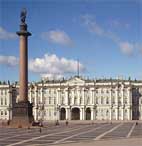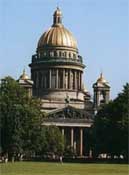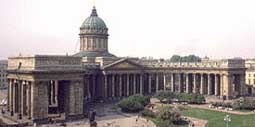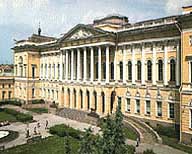|
Люблю
тебя, Петра творение,
Люблю твой строгий, стройный
вид,
Невы державное течение,
Береговой ее гранит...
А.С. ПУШКИН
 Our
city was found in 1703 by the great Russian Tsar Peter I.
The aim was to return Russian lands and Our
city was found in 1703 by the great Russian Tsar Peter I.
The aim was to return Russian lands and give to the vast country the natural outlet to the Baltic
Sea. From the very begining of the construction of the city
Peter I - decided to make St. Petersburg a new capital of
Russia. The
dream was - to create a real
brilliant European capital.
give to the vast country the natural outlet to the Baltic
Sea. From the very begining of the construction of the city
Peter I - decided to make St. Petersburg a new capital of
Russia. The
dream was - to create a real
brilliant European capital.
In May, 1703 Peter and Paul Fortress was laid in Zayachy
Island. The architect was D.Trezini. Fortress is of a
hexagon shape with six bastions which defenced with the
artillery fire the waterways to the city. In the center of
the Fortress there is St. Peter and Paul Cathedral. The
gilded spire of the Cathedral is crowned with the angel. The
legend says this angel is guarding the city. The heart of
the city is the Palace Square on which the Winter Palace,
the building of the General Staff and the building of the Ministries are located. The Winter
Palace was an oficial Tsar Residence. Nowadays here is the
State Hermitage Museum one of the greatest museums in the
world. The Hermitage Museum consists of several buildings -
the Small Hermitage, the Big Hermitage, the Hermitage
Theatre and the New Hermitage.
Rubens, Rembrandt, Leonardo da Vinci, Tician and many other
great masters are on display in the
State Hermitage Museum.
and the building of the Ministries are located. The Winter
Palace was an oficial Tsar Residence. Nowadays here is the
State Hermitage Museum one of the greatest museums in the
world. The Hermitage Museum consists of several buildings -
the Small Hermitage, the Big Hermitage, the Hermitage
Theatre and the New Hermitage.
Rubens, Rembrandt, Leonardo da Vinci, Tician and many other
great masters are on display in the
State Hermitage Museum.
In 1710 the Capital of Russia was
transferred to St Petersburg from Moscow, while in 1712
the Tsar Family and households together with the major
 Governmental
Bodies moved to St.Petersburg. Among the most magnificent
architectural monuments is the St.Isac’s
Cathedral which was erected
according to O.Monferan’s
drowings and which was being built during
40 years. The building strikes the imagination with it’s
sizes: its length 111,5м;
width 97,6м;
height 101,8м. Governmental
Bodies moved to St.Petersburg. Among the most magnificent
architectural monuments is the St.Isac’s
Cathedral which was erected
according to O.Monferan’s
drowings and which was being built during
40 years. The building strikes the imagination with it’s
sizes: its length 111,5м;
width 97,6м;
height 101,8м.
The very popular place for the rest of the tourists and
cityzens is the square in
front of the Kazan Cathedral.
 The
architect of this great Cathedral is a famous Russian The
architect of this great Cathedral is a famous Russian architect Voronichin. The work upon the construction of the
Kazan Cathedral started in 1801 and was finished in 1811г.
The Cathedral is made in a shape
of the extended cross, the height
of it is 71,6м.
The Cathedral of our Lady of Kazan is dedicated to the
victory of the Russian Army in Napoleonic Company of the
1812. In 1837г.
in front of the Cathedral there were erected two monuments
devoted to the heroes of the Patriotic War of 1812 -
Fieldmarshal M.I.Kutuzov and
M.B.Barklay
De Tolly.
architect Voronichin. The work upon the construction of the
Kazan Cathedral started in 1801 and was finished in 1811г.
The Cathedral is made in a shape
of the extended cross, the height
of it is 71,6м.
The Cathedral of our Lady of Kazan is dedicated to the
victory of the Russian Army in Napoleonic Company of the
1812. In 1837г.
in front of the Cathedral there were erected two monuments
devoted to the heroes of the Patriotic War of 1812 -
Fieldmarshal M.I.Kutuzov and
M.B.Barklay
De Tolly.
The well-known monument to
Peter The Great - "The Bronse Horseman" was constructed in
1782
on the Senate Square. Falcone is the sculptor of the monument, the
model of a head was executed by the Falcone’s
Senate Square. Falcone is the sculptor of the monument, the
model of a head was executed by the Falcone’s
 pupil
Maria Kollo. pupil
Maria Kollo.
One of the most beautiful places in the city is the Square
of Arts. The design of this Square was done by the famous
architect Karl Rossi. This name is a very important one in
our city because a lot of the nice places,
squares and palaces were created according to his drowings.
On the Square of Arts there are
the Russian Museum, the Musorgskiy’s Theatre, the
Philarmonic Society, the Museum of Ethnography. In
1819 the Tsar Alexander I commissioned to Karl Rossi to
construct the palace on this territory. Alexander I wanted
to present it to his junior brother Mickael - hence the
name of the Palace - Mickael’s Palace. Now in the Palace there is the Russian Museum. On
a display here the works of the Russian fine arts from the
icon paintings to the works of avant-guard. .
Palace. Now in the Palace there is the Russian Museum. On
a display here the works of the Russian fine arts from the
icon paintings to the works of avant-guard. .
Neva and its numerous cannels make the organic unity with
the architecture of the city. In the city there are
86 rivers, cannels, more than 100 lakes and ponds. May be
because of this reason St. Petersburg
 sometimes
is called - the Northern Venice. During the constructing of
the city the river was connected with
the cannels, as a result the new islands were formed. A
century and half ago in the city there were 101 islands,
but later on the rivers and cannels were filled with earth
and today in St. Petersburg there are 42 sometimes
is called - the Northern Venice. During the constructing of
the city the river was connected with
the cannels, as a result the new islands were formed. A
century and half ago in the city there were 101 islands,
but later on the rivers and cannels were filled with earth
and today in St. Petersburg there are 42 islands. These islands are
connected with the numerous of bridges which are the
symbols of the city as well.
islands. These islands are
connected with the numerous of bridges which are the
symbols of the city as well.
The Spit of Vasilevsky Island
subdivides the Neva river into two sleeves: the Big and the
Small Nevas. In 1810 on the
territory of the Spit of Vasilevsky Island two Rostral
columns were established in front of the building of the
Stock Exchange. The sculptural figures at the foundation of
the columns symbolize the great Russian Rivers the Neva, the
Volkhov, the Volga and the Dniper.
On the top of the columns there are the fires which were
the beacons in the previous centuries. The Stock
Exchange building nowadays accommodates the exposition of
the Central Naval Museum.
  

|
|